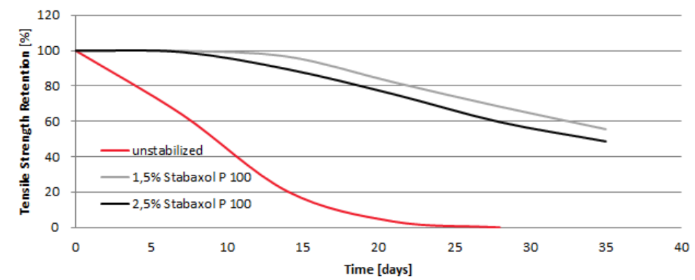Enhanced TDS
Identification & Functionality
- Chemical Family
- Plastics & Elastomers Functions
- Product Code
- MITM09358
- Technologies
- Product Families
Features & Benefits
- Labeling Claims
Applications & Uses
- Compatible Polymers & Resins
Properties
- Physical Form
Technical Details & Test Data
- Technical Data
The main application of Stabaxol® P 100 is hydrolysis protection of PET, PBT, PA and TPE. The addition of merely 2.0 weight-% Stabaxol® P 100 to PET increases the life time of the latter by 3 - 4 times. Depending on the number of acid end groups and the humidity content of the polymer to be stabilized, as well as the stabilizing effect to be obtained, it is recommended to use 1.0 - 2.5 weight-% Stabaxol® P 100. The most suitable dosage depends on the requirements to be met and should always be ascertained in preliminary trials. Stabaxol® P 100 is preferably metered separately to the infeeding zone of the extruder.
Hydrolytic Stability of Polyester based Polyurethane Elastomers

Stabaxol® P 100 can be processed on any unit suitable for polyester and polyamide processing which provides sufficient dispersion of the material in the polymer. In respect of the extruder equipment, experience shows that it is advisable to use a twin-screw extruder equipped with a L/D ratio > 38. Appropriate cooling of the feeding zone is recommended to avoid particle accumulation in the feeding area. At processing temperature traces of volatile matters can escape, which may temporarily cause irritation of skin, eyes and respiratory passages. It is highly recommended to provide adequate local ventilation at all places where Stabaxol® P 100 stabilized products are exposed to temperatures exceeding 200 °C (392 °F). In particular, it is necessary to avoid direct contact with volatile emissions. For easy dosing and homogenizing, Stabaxol® P 100 is available as masterbatch based on the corresponding polymers.
Packaging & Availability
- Packaging Type
Principal Information
- Group Principal Number
- S000008
- Principal
Storage & Handling
- Storage Conditions
According to experience available, if stored at about 20 °C (68 °F) in originally closed containers, Stabaxol® P 100 can be kept for 24 months without becoming less effective. Store in cool and dry place. During transportation or in case of prolonged storage at slightly elevated temperatures, one might observe agglomeration of the particles. Please make sure that such agglomerations are being broken prior to use.
Other
- Appearance
- Yellowish powder amber colored pastilles
- Appearance (SDS)
- Powder
- Color (SDS)
- Light, yellow
- Flammable Nature (SDS)
- May form explosive dust - air mixture
- Insoluble in (SDS)
- Water
- Item Number
- Odor (SDS)
- Slight
- Other Hazards
- None known
- Temperature Control
- No
- USA/DOT UN Number
- Not Applicable
- Application Information
Value Units Test Method / Conditions Dosage (Use Level) 1.0-2.5 - - Material Composition
Value Units Test Method / Conditions Carbodiimide Content min. 13.0 % % - Physical Properties
Value Units Test Method / Conditions Density 1.05 g/cm³ g/cm³ At 20°C Melting Point 100.0-120.0 °C °C - SDS Physical and Chemical Properties
Value Units Test Method / Conditions Autoignition Temperature (SDS) min. 455.0 °C °C Decomposition Temperature (SDS) 260.0 °C °C Density (SDS) 1.05 g/cm³ g/cm³ at 20°C Flash Point (SDS) min. 322.0 °C °C Closed Cup Melting Point (SDS) 100.0-120.0 °C °C - Shelf Life & Stability
Value Units Test Method / Conditions Shelf Life 24.0 -
